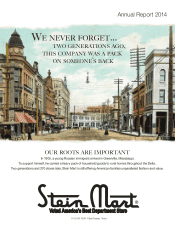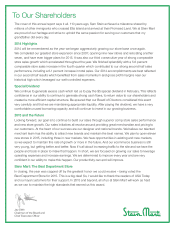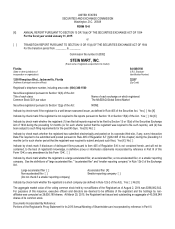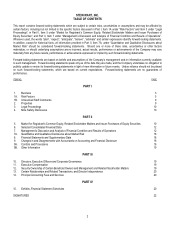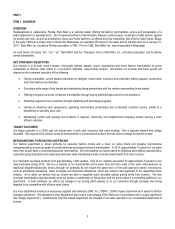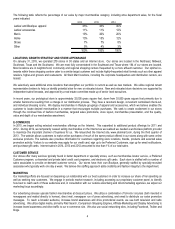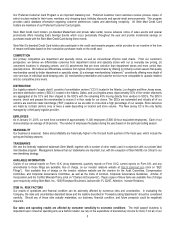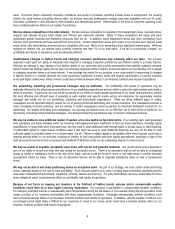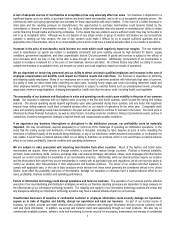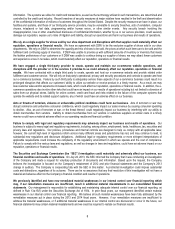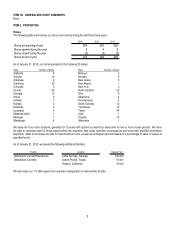Stein Mart 2014 Annual Report Download - page 8
Download and view the complete annual report
Please find page 8 of the 2014 Stein Mart annual report below. You can navigate through the pages in the report by either clicking on the pages listed below, or by using the keyword search tool below to find specific information within the annual report.6
sales. Economic factors impacting consumer confidence and levels of consumer spending include levels of employment, the housing
market, the stock market, prevailing interest rates, tax policies, personal bankruptcies, energy costs and availability and cost of credit.
Consumer confidence is also affected by both domestic and international events. Deterioration in the level of consumer spending could
have a material adverse effect on our results of operations.
We face intense competition in the retail industry. We face intense competition for customers from department stores, specialty stores,
regional and national off-price retail chains and Internet and mail-order retailers. Many of these competitors are larger and have
significantly greater financial and marketing resources than we do. In addition, many department stores and other competitors have
become more promotional and have reduced their price points. Certain department stores and certain of our vendors have opened outlet
stores which offer merchandise at prices that are competitive with ours. Many of our competitors have significant Internet sales. While we
maintain an Internet site, our Internet sales currently comprise less than 1% of our total sales. If we fail to successfully compete, our
profitability and results of operations could be adversely affected.
Unanticipated changes in fashion trends and changing consumer preferences may adversely affect our sales. Our success
depends in part upon our ability to anticipate and respond to changing consumer preferences and fashion trends in a timely manner.
Although we attempt to stay abreast of the fashion tastes of our customers and provide merchandise that satisfies customer demand,
fashion trends can change rapidly and we may not accurately anticipate shifts in fashion trends and adjust our merchandise mix to appeal
to changing consumer tastes in a timely manner. If we misjudge the market for our products or are unsuccessful in responding to changes
in fashion trends or in market demand, we could experience insufficient inventory levels and missed opportunities, or excess inventory
levels and higher markdowns, either of which could have a material adverse effect on our financial condition and results of operations.
Our advertising, marketing and promotional strategies may be ineffective. Our profitability and results of operations may be
materially affected by the effectiveness and efficiency of our marketing expenditures and our ability to select the right markets and media in
which to advertise. In particular, we may not be successful in our efforts to create greater awareness of our stores and promotions, identify
the most effective and efficient level of spending in each market and specific media vehicle and determine the appropriate creative
message and media mix for our advertising, marketing and promotional expenditures. While we utilize different types of media,
newspapers are an important delivery vehicle for run of press promotional advertising and circular insertions. The newspaper business is
under increasing economic pressure, and the demise of certain newspapers would jeopardize an important distribution method for our
advertising. As readers shift away from newspapers, our success will depend more on our effective use of other forms of media for our
advertising, marketing and promotional strategies. Our planned marketing expenditures may not result in increased revenues.
We may be unable to raise additional capital, if needed, or to raise capital on favorable terms. If our existing cash, cash generated
from operations and funds available under our revolving credit agreement were insufficient to fund our future operations, including capital
expenditures, or repay debt when it becomes due, we may need to raise additional funds through public or private equity or debt financing.
If unfavorable capital or credit market conditions exist if and when we were to seek additional financing, we may not be able to raise
sufficient capital on favorable terms or on a timely basis, if at all. Failure to obtain capital on acceptable terms when required could have a
material adverse effect on our business including an inability to fund new growth and other capital expenditures, especially in light of the
debt we recently incurred to fund our special cash dividend of $5.00 per share on our outstanding shares of common stock.
We may be unable to negotiate acceptable lease terms with current and potential landlords. Our growth and success depends in
part on our ability to renew and enter into new leases for successful stores. There is no assurance that we will be able to re-negotiate
leases at similar or satisfactory terms at the end of the lease, and we could be forced to move or exit trade areas if another favorable
arrangement cannot be made. There is also no assurance that we will be able to negotiate satisfactory terms on new or replacement
stores.
We may not be able to exit under-performing stores on acceptable terms. As part of our strategy, we close certain under-performing
stores, generally based on the lack of store profitability. Such closures subject us to costs, including lease termination payments and the
write-down of leasehold improvements, equipment, furniture, fixtures and inventory. For early terminations, we may remain liable for future
lease obligations which could adversely affect our profitability and results of operations.
Because of our focus on keeping our inventory at the forefront of fashion trends, extreme and/or unseasonable weather
conditions could force us to have higher inventory markdowns. Our business is susceptible to unseasonable weather conditions.
For example, extended periods of unseasonably warm temperatures during the fall season or cool weather during the spring season could
render a portion of our inventory incompatible with those unseasonable conditions. Prolonged unseasonable weather conditions could
have a material adverse effect on our business, financial condition and results of operations. In addition, extreme weather conditions over
a prolonged period might make it difficult for our customers to travel to our stores, which could have a material adverse effect on our
business, financial condition and results of operations.

